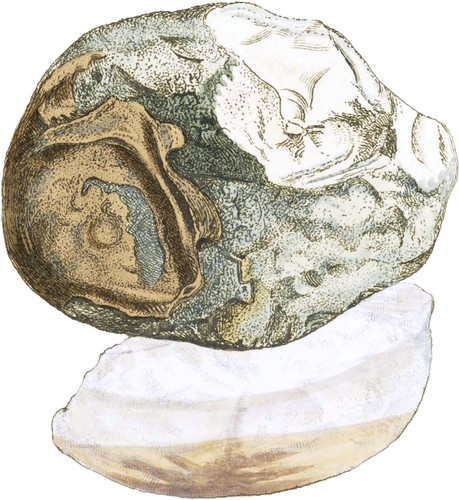 Enlarge
Enlarge
British Mineralogy
Decomposing Flint
- Class 2. Earths.
- Ord. 1. Homogeneous.
- Gen. 4. Silex.
- Spec. 1. Quartz.
- Div. 3. Amorphous.
This decomposing state of Flint very much resembles, and is probably the same as. Quartz nectique of Haüy, the Schwimmstein of Werner, and the Float-stone of Jameson, said to be found only at St. Omer, near Paris. The specimens that I have seen in the intermediate state from thence are more approaching to Hornstonc or Jasper, of a yellowish or reddish tinge as also of the grayer tinges. This soft state is not common, although far from so rare as might be expected. The outsider and even insides of Flints in Chalk are sometimes of the same nature, and pass more or less gradually into Chalk, or vice versâ; and this has given rise to the idea of the earths passing into each other even chemically.
The present specimen is from near the surface of the dark clay commonly called Blue Clay on the north side of nighgate-lull, and was found with many others in a remarkable and curious situation, viz., adhering to the outside of home of the Septaria. Scarcely one Flint besides has been found in the same dark clay: and geologists consider Flints, especially Pebbles or tuberose Flints, as not belonging to it. Their being attached to some of the Septaria, which are so common without them, makes them the more extraordinary. At the same time shells are attached to this Float-stone, frequently oyster-shells, which I have not met with in other parts of the Clay, and those contorted or adapted to the shape of the stone., and having merely the edges and hinge a little protuberating, so that the stone itself is part of the animal’s case towards the middle. The shell might, if it did not seem too nearly allied to Ostrea edulis, be called perforata or parasitica. I have had soft flint pebbles from a well dug in Richmond park, that were apparently found loose among the same kind of clay. They all incline to the common gray appearance of pebbles; see plate 88, lower left hand figure;—being very soft, the coat differing but little as to colour, sometimes it is a little paler, and it is less shining. They all feel light in the hand*, and differ according to the quantity of the softened or decomposed part. These of Highgate are, however, more largely conspicuous, and were observed by my attentive friend B. G. Snow, esq. who has so kindly assisted me with specimens to elucidate the natural history of the mineral productions of that little but remarkable hill, the productions of which will be a memorial of it to future generations, when otherwise it might have been forgotten.
These stones have evident marks upon them of having been rolled.—Besides the specimen with an oyster-shell attached, I have one with a sharp impression of an Echinus’ spine.
- * I think, however, that they absorb the water ton quickly to deserve the name of Float-stone.

